We fell in love with Kinder goats in the spring of 2015. Some family friends had just welcomed several sets of Kinder goat kids to their farm, and they invited us to come to play with the babies. Having grown up on a cattle ranch, keeping goats on our homestead was the furthest thing from my mind! I took my kids over, thinking it could be a fun experience for them. Just one hour of cuddling baby goats and watching them play, and I was hooked!
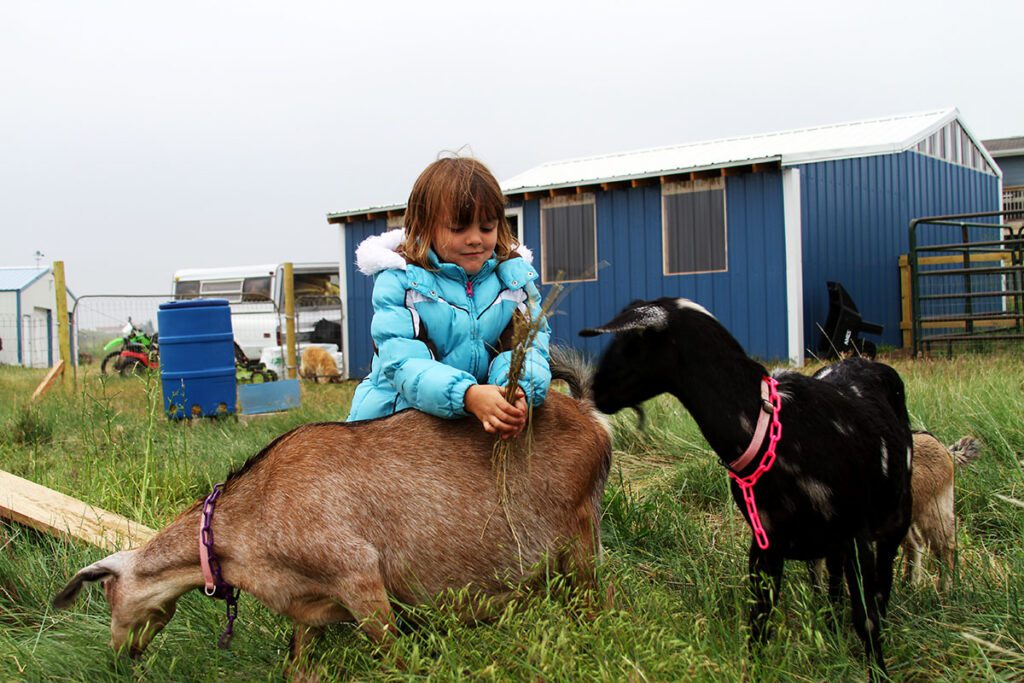
Our first goats came home that summer. A doe in milk, with her spring wether, and a first-freshener whose kids had recently been weaned. We traveled about 4 hours to get them, so we would have new bloodlines when it came time to breed the does. We’ve learned a lot since we brought the first goats home, but I haven’t ever regretted our decision to breed and raise Kinders.
Why We Raise Kinder Goats

Once I made the decision that goats would be the ideal livestock for our small acreage, I did a lot of research about different breeds. I knew I wanted a dairy-type animal to provide milk for our family, and I was interested in learning to make cheese. Our youngest child was only three at the time, so kid-friendly animals were a must-have.
Kinder’s size, temperament, dual-purpose characteristics, and maternal abilities kept leading us back to the breed. They have proved to be the perfect choice for our homestead-turned-farm.
Size:

Kinder goats are a small to medium-sized breed. They are larger than the dwarf breeds (Nigerian dwarf or pygmy,) but smaller than standard dairy breeds like Nubians, LaManchas, or any of the Swiss types. In our experience, this makes them easier to handle and less intimidating for small children.
They can vary quite a bit in size depending on their genetics. First-generation Kinders are bred by crossing a registered Pygmy buck with a registered Nubian doe so there is a lot of opportunity for variation, especially in the early generations. However, most does in our herd end up about the size of a large dog (think big Golden Retriever).
Temperament:
Most of our goats are extremely friendly. The kids crawl in our laps and love to chew on ponytails! Our does enjoy having their heads scratched, and will come from across the pasture when they hear us call. Like all animals, some are friendlier than others, while some tend to be shy. We’ve yet to have a doe who is pushy toward humans. Even our full-grown bucks like attention – if you can stand their smell!
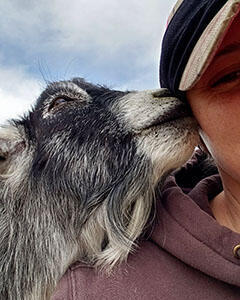
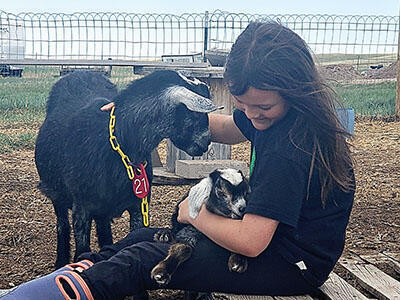
Dual-purpose Characteristics:
Home Dairy
Goats are a great choice for a family looking to own a dairy animal! Goat milk is easily digestible and can be a great option if you are lactose intolerant. Goats produce less milk than cows, which is actually a good thing for most families. Plus, they require less space and feed than cows do.
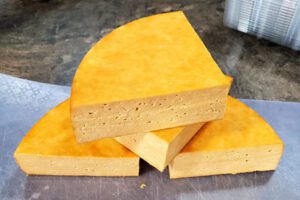
Kinder goat milk is sweet and creamy, without the “goaty” flavor associated with some of the other breeds. It is high in protein, butter fat, and milk solids. I’ve found that this translates into a higher yield of cheese and yogurt than most recipes predict.
I milk our does once daily, and share with their kids until they are weaned. Most of our does are easily hand-milked with decent-sized teats and orifices. They generally give 1-3 quarts per day, depending on the stage of their lactation.
Meat Production
Kinder goats are carefully selected for both meat and dairy characteristics. They are not intended to grow to the same size and weight as standard meat breeds such as Boers or Kikos. However, when compared to standard or mini dairy breeds, Kinders are more heavily muscled and provide higher meat yields.
Maternal Instinct:
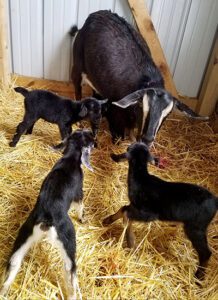
Twins, triplets, and quadruplets are common in Kinder goats. Their average litter size is 3 kids. We have always chosen to let mothers raise their kids. Our does are good mothers, and typically kid easily. Occasionally a doe will need assistance if a large kid gets stuck in the birth canal, or if multiple kids get tangled, but that is the exception, not the rule.
When a doe gets close to kidding, we separate her into a kidding pen. This gives her privacy when the kids are born, keeps the babies from getting stepped-on by herd mates, and allows mama and babies to bond before rejoining the rest of the herd.
Every spring we eagerly anticipate the arrival of new goat babies. It’s so much fun to see how many are born, what color they are, and whether they are boys or girls. There’s not much cuter than a baby goat. And nothing beats their snuggles!
Are you interested in adding Kinder goats to your farm or homestead?
We’d love to connect. You can email us here with questions, or add your name to our reservation list.
Follow our Windy Hill Kinders herd page on Facebook!
Related Content:
- How to Choose the Right Livestock For Your Family
 Deciding when, how, and which livestock to add to your farm or homestead is a personal preference. Regardless of how big or small they are, all livestock come with chores,… Read more: How to Choose the Right Livestock For Your Family
Deciding when, how, and which livestock to add to your farm or homestead is a personal preference. Regardless of how big or small they are, all livestock come with chores,… Read more: How to Choose the Right Livestock For Your Family - Pregnant Goat Care (Countdown to Kidding)
 Trimming hooves, updating vaccinations, and providing mineral supplements are important to keep our does healthy during the last month of their pregnancy. This care is also important for the kids… Read more: Pregnant Goat Care (Countdown to Kidding)
Trimming hooves, updating vaccinations, and providing mineral supplements are important to keep our does healthy during the last month of their pregnancy. This care is also important for the kids… Read more: Pregnant Goat Care (Countdown to Kidding) - DIY Goat Kidding Pens
 Goat kidding pens are small pens, sized for a single doe and her newborn kids. This small pen provides a private space for a doe to give birth and bond… Read more: DIY Goat Kidding Pens
Goat kidding pens are small pens, sized for a single doe and her newborn kids. This small pen provides a private space for a doe to give birth and bond… Read more: DIY Goat Kidding Pens
